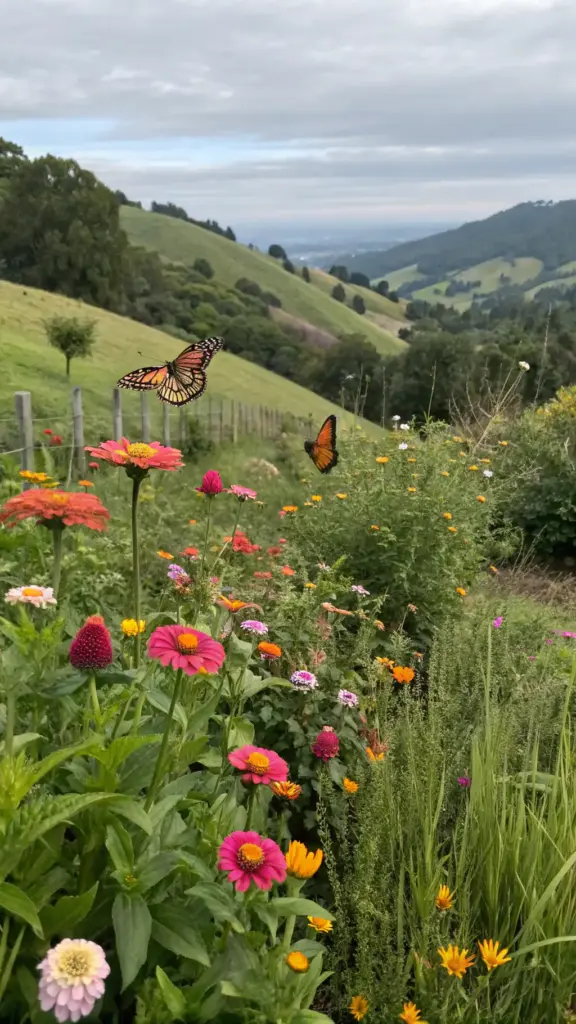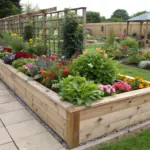9. Butterfly-Friendly Blooms: Turning Your Hillside into a Fluttering Paradise

There’s something magical about watching butterflies dance through the air, isn’t there? A few years ago, I decided to transform my hillside into a butterfly-friendly bloomscape, and let me tell you—it’s been one of the most rewarding projects I’ve ever tackled. Not only did it bring life and color to my garden, but it also created a space where kids and families could connect with nature. If you’re ready to attract these beautiful pollinators, let’s dive into how to plant the right blooms, create sheltered habitats, and keep the butterflies coming back season after season.
Planting Milkweed, Coneflowers, and Zinnias
The secret to attracting butterflies lies in choosing the right plants—and milkweed, coneflowers, and zinnias are absolute magnets for them.
Milkweed is especially important because it’s the only plant monarch butterflies will lay their eggs on. I planted a patch of swamp milkweed near the edge of my hill, and within weeks, I spotted tiny caterpillars munching away. It was like having front-row seats to nature’s show!
Coneflowers and zinnias, on the other hand, are nectar powerhouses. The bright oranges, purples, and yellows of coneflowers draw in butterflies like crazy, while zinnias add a pop of color that lasts all summer. One summer, I mixed zinnias with lavender and marigolds, and the combination was chef’s kiss—both visually stunning and irresistible to pollinators.
Pro tip: Plant in clusters rather than scattering individual flowers. Butterflies are more likely to notice large patches of color, and it makes your garden look intentional and vibrant.
Creating Sheltered Areas for Butterfly Habitats
Butterflies need more than just food—they need safe spaces to rest and take shelter. That’s why creating sheltered areas is key to keeping them around.
I strategically placed a few flat rocks in sunny spots along my hillside. These act as natural sunbathing stations for butterflies, who love to warm their wings before flying. I also added a small brush pile at the base of the hill using fallen branches and leaves. It might not look like much, but it provides a cozy hideaway for butterflies during cooler nights or bad weather.
Here’s a fun idea: build a butterfly house! These little wooden structures mimic natural shelters and can be tucked into corners of your garden. I made one out of scrap wood, painted it a soft pastel color, and mounted it on a post. It’s become a charming focal point—and a functional one, too.
Seasonal Rotation of Plants for Continuous Visits
If you want butterflies to stick around year-round (or at least as long as the weather allows), you’ll need to plan for a seasonal rotation of blooms.
In spring, I rely on early bloomers like daisies and phlox to get things started. By summer, the milkweed, coneflowers, and zinnias take center stage. And in fall, asters and goldenrod keep the party going until the first frost.
One mistake I made early on was planting only summer-blooming flowers. Once August rolled around, the garden felt empty, and so did the butterfly population. Now, I make sure to mix early, mid, and late-season bloomers for continuous color and activity.
Pro tip: Keep a gardening journal to track what blooms when. It’s a simple way to ensure you’re always one step ahead of the seasons.
Educational Benefits for Kids and Families
A butterfly-friendly garden isn’t just for adults—it’s an incredible learning tool for kids and families. Watching caterpillars transform into butterflies is like witnessing a real-life magic trick, and it sparks curiosity about nature’s cycles.
Last summer, I invited some neighborhood kids over to help plant milkweed and observe the monarch lifecycle up close. They were absolutely mesmerized by the tiny eggs and wriggly caterpillars. It turned into an impromptu science lesson, complete with squeals of excitement when the first butterfly emerged from its chrysalis.
And here’s the best part: this kind of hands-on learning fosters a deeper appreciation for the environment. Kids who grow up surrounded by nature are more likely to care for it as adults. Plus, it’s just plain fun!
Alright, ready to add some nighttime magic to your garden? Click the next button below to discover how to create a nighttime glow garden filled with moonflowers, evening primrose, and solar-powered lighting. Spoiler: it’s perfect for hosting twilight gatherings or simply enjoying a peaceful evening under the stars!









GIPHY App Key not set. Please check settings